Century High Stadium Sign Is Headed To Historical Park To Honor Kayo Stanton, The Voice Of The Blackcats
May 15, 2020
“Heeeeeeerrrrrrrrrrreeeee come the Blackcats!”
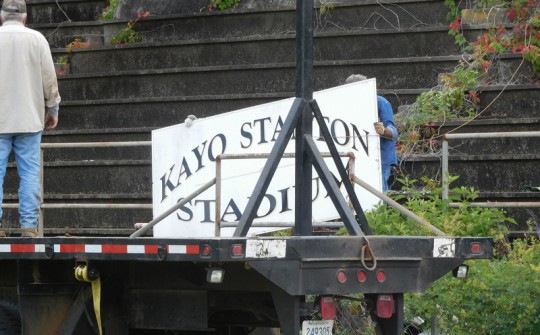 So many times those words echoed through Kayo Stanton Stadium at the former Century High School. Very little of the stadium remains today; the remnants of the home bleachers and the press box remain, but they suffered heavy structural damage during the EF-3 tornado that hit Century on February 15, 2015.
So many times those words echoed through Kayo Stanton Stadium at the former Century High School. Very little of the stadium remains today; the remnants of the home bleachers and the press box remain, but they suffered heavy structural damage during the EF-3 tornado that hit Century on February 15, 2015.
On Thursday, crews used a crane to remove the “Kayo Stanton Stadium” sign from outside the press box and transported it to the Alger-Sullivan Historical Park where it will be put on display.
The main Century High School school building was constructed in 1937. Century High School closed a quarter century ago after being merged with Ernest Ward High School in Walnut Hill to form the current Northview High School.
(article continues below photo)
Who was Kayo Stanton?
Kayo’s full name was Vivian Earl Stanton, Jr. “Kayo” is a term used in boxing to denote a knockout but his daughter Anne Williamson of Thomasville said his nickname was for a character in the 1930s-50s “Moon Mullins” Sunday comic strip named “Kayo.”
Stanton’s deep voice was easily recognizable – his trademark was “Heeeeeeerrrrrrrrrrreeeee come the Blackcats,” as the Century team came onto the field before the game started. His son, David Stanton said his father borrowed the line from the Florida Gators after attending games in Gainesville when David was a student there. “He came back and tried it, and it went over pretty good,” he said. “He kept it for the next 20 years.”
Kayo didn’t try to be a play-by-play announcer. He once said, “The fans can see what’s going on. I just tell them the yard marker, since we can see from this high vantage point. The men who work as spotters in the press box tell me the players’ numbers and I pass that to the crowd.”
The stadium was named in his honor during the football season of 1990. He was beginning to be paralyzed from the cancer by the end of the football season, but he could still walk some at the time of the dedication. By the end of the season he was confined to a wheelchair and would listen to the games from the wheelchair sitting in his front yard.
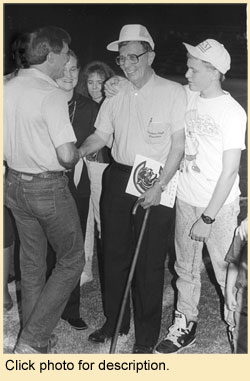 Stanton was “The Voice of the Blackcats” as public address announcer for Century football for 40 years, starting in the early 1950s.
Stanton was “The Voice of the Blackcats” as public address announcer for Century football for 40 years, starting in the early 1950s.
Stanton was also a third generation businessman in Century. At 19, he went to work for his father, Bubba Stanton, at Stanton’s grocery on Mayo Street. The family closed the grocery store in 1963, and when Bubba died in 1964, Kayo took over the operation and eventually turned it into a furniture store.
Stanton prepared for games as if he were going to broadcast them, studying series records against Century’s opposition for the week and scores against common opponents, to be shared with the fans.
His attendance record was almost spotless, even after he opened another store in Pensacola in 1979. The new store kept him out of town for much of the week in the six years it was open. But Fridays always found him in the press box.
Stanton’s tenure was interrupted only once, as family ties put him in a different place in the stadium during the 1968 season. That was the senior season for Kayo’s son David, an All-State linebacker for Century.
But he returned to the booth the following year and stayed for the next 20 years, before cancer forced him to give up announcing. He died June 13, 1991.
(article continues below photo)
Century Blackcat Football
Century’s high school ventured into football in the early 1930s. According to “Blackcats: A history of Century Football 1931-1975″ by Jim Curenton, football was first played behind the Baptist and Methodist churches in 1931. In 1934, Marvin Kelly donated a parcel of land northwest of the present-day Carver-Century K-8 (the site of present-day Showalter Park) and it was used for Century’s athletic teams. Football was played at Kelly Field during the daytime hours since there were no lights.
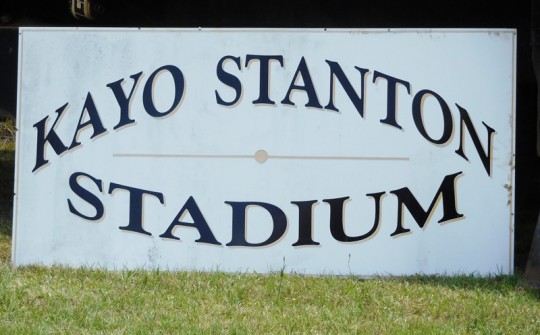 It’s not clear just when the first games were played at the new high school, built in 1936. Curenton’s book says of the 1941 season, “Kelly Field had not been used as a football field in two or three years.” At any rate, at the end of World War II, for the first time, home games were played under lights on the field behind the new high school. Century played its first night game against W.S. Neal. A solid white ball was used to make it more visible at night. Curenton reported that since grandstands were non-existent and there were no fences as yet, crowds pressed closer and closer to the action, actually narrowing the field of play.
It’s not clear just when the first games were played at the new high school, built in 1936. Curenton’s book says of the 1941 season, “Kelly Field had not been used as a football field in two or three years.” At any rate, at the end of World War II, for the first time, home games were played under lights on the field behind the new high school. Century played its first night game against W.S. Neal. A solid white ball was used to make it more visible at night. Curenton reported that since grandstands were non-existent and there were no fences as yet, crowds pressed closer and closer to the action, actually narrowing the field of play.
The school property bordered the crest of a hill on the edge of a small swamp around Findley Branch. Coach Bill Turberville took advantage of the slope. He had the boys carry each other up the hill repeatedly to build the legs and endurance of the players. Coaches following Turberville also used the slope for practice drills, and Eddie Simmons believes Coach Jay Smith made the most use of it. He had two boys race down the hill – one boy had to block them both and push them back up the hill. He would alternate two on one going up and then going down, tackling and blocking.
By 1944 a grandstand was erected on the north side of the field. It was a wooden affair with about five or so rows of seats, seating maybe some 50 people. However, it was a start. It was a sign of progress and of a “slowly growing interest in high school football,” according to Curenton. Crowds increased and that resulted in larger stands being constructed. Later cars pulled up to the fence on the south side and fans sat in their autos, blowing their horns when there was an exceptional play. About 1948, a grandstand and dressing rooms were built with wooden seats atop them. Running water was added to the dressing rooms in 1952, with Kayo Stanton doing most of the plumbing work.
Grover Hicks, Mr. Peavy and Angus Hall of the county’s maintenance crew used wheelbarrows to build a concrete extension onto the east end of the existing grandstand that was used by opponents’ fans.
A deep gully at the east end was filled in during Jim Manderson’s coaching tenure at CHS some time during 1952-54. A classroom was built adjacent to the southwest corner end zone and encroached on the end zone. In the 1980s, Paul Jones, owner of the land east of the field, donated property so the field could be extended in that direction.
The cement grandstand and press box on the south side wasbuilt with the help of the Century High School Quarterback Club in the 1960s and 70s.
Historical information and photos courtesy Jerry Simmons, Alger-Sullivan Historical Society. Modern day stadium photos for NorthEscambia.com, click to enlarge.
Comments
5 Responses to “Century High Stadium Sign Is Headed To Historical Park To Honor Kayo Stanton, The Voice Of The Blackcats”



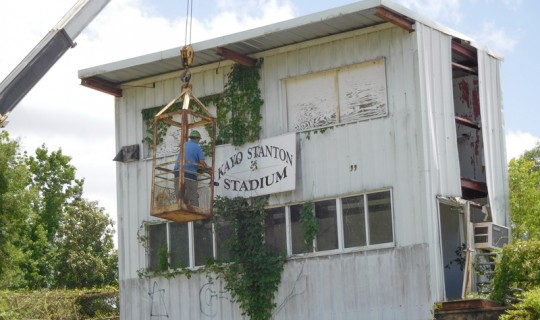
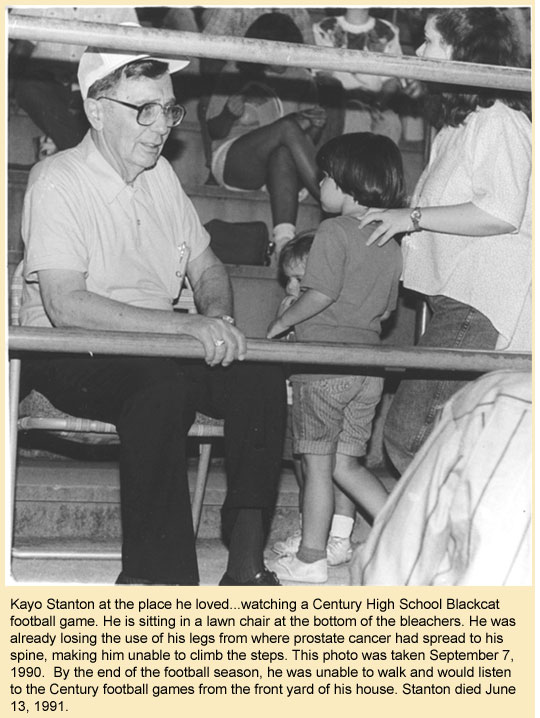
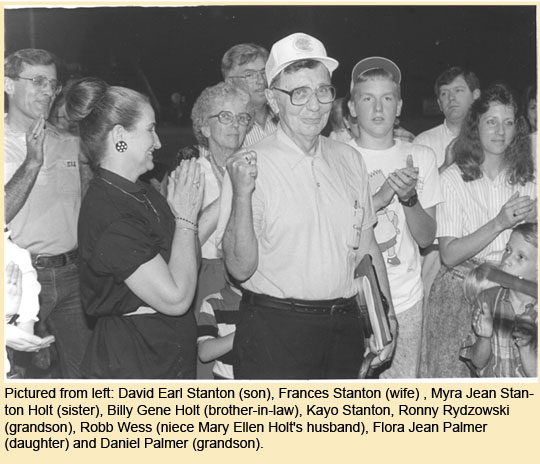
have many wonderful memories of this field,both my brothers and myself played on this field,an i remember going there to watch the blackcats play some big games there and saw several sawdust bowlsplayed there,so many memories you brought back thank you
How many of us didn’t just read “Heeeeeeerrrrrrrrrrreeeee come the Blackcats!”, but heard it in Mr Stanton’s voice? Thanks for the memories.
Those Were The Days My Friend I Thought Theyd Never End.
Who remembers the “BO & KO” radio show? It was before the White Brothers were doing theirs and Bo Brantley, voice of the Hurricanes, and Kayo would do interviews with the coaches and stuff on Friday afternoons before the games.
I followed my. Dad and Mom’s foot steps in some ways. I purchased every item that I could, for every room to furnish a home from Mr. and Mrs. Stanton for over 30 years of credit I had with them and (Embarrassed to say 3 on/off marriages). To me there were no better people for a struggling young man. Another was Mr. Bill Turberville